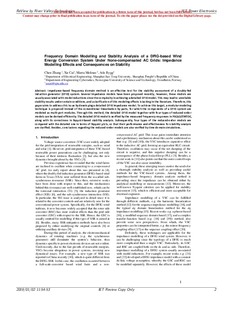| dc.contributor.author | Zhang, Chen | |
| dc.contributor.author | Molinas Cabrera, Maria Marta | |
| dc.contributor.author | Rygg, Atle | |
| dc.contributor.author | Cai, Xu | |
| dc.date.accessioned | 2019-01-05T12:37:54Z | |
| dc.date.available | 2019-01-05T12:37:54Z | |
| dc.date.created | 2019-01-04T11:11:04Z | |
| dc.date.issued | 2019 | |
| dc.identifier.issn | 1755-4543 | |
| dc.identifier.uri | http://hdl.handle.net/11250/2579321 | |
| dc.description.abstract | Impedance-based frequency domain method is an effective tool for the stability assessment of a doubly-fed induction generator (DFIG) system. Several impedance models have been proposed recently, however, these models are usually associated with model reductions since the complexity in achieving a detailed DFIG model. This may lead to unreliable stability results under certain conditions, and a clarification of this modeling effects is lacking in the literature. Therefore, this paper aims to address this issue by developing a detailed DFIG impedance model. To achieve this target, a modular modeling technique is proposed instead of the conventional linearization by parts, for which the components of a DFIG system are modeled as multi-port modules. Through this method, the detailed DFIG model together with four types of reduced-order models can be derived efficiently. The detailed DFIG model is verified by the measured frequency responsesin PSCAD/EMTDC, along with its correctness in Nyquist-based stability analysis. Subsequently, four types of the reduced-order models are compared with the detailed one in terms of Nyquist plots, so that their performance and effectiveness for stability analysis are clarified. Besides, conclusions regarding the reduced-order models are also verified by time domain simulations | nb_NO |
| dc.language.iso | eng | nb_NO |
| dc.publisher | Institution of Engineering and Technology (IET) | nb_NO |
| dc.title | Frequency Domain Modelling and Stability Analysis of a DFIG-based Wind Energy Conversion System Under None-compensated AC Grids: Impedance Modelling Effects and Consequences on Stability | nb_NO |
| dc.type | Journal article | nb_NO |
| dc.type | Peer reviewed | nb_NO |
| dc.description.version | acceptedVersion | nb_NO |
| dc.source.journal | IET Power Electronics | nb_NO |
| dc.identifier.doi | 10.1049/iet-pel.2018.5527 | |
| dc.identifier.cristin | 1650266 | |
| dc.description.localcode | This paper is a postprint of a paper submitted to and accepted for publication in [IET Power Electronics] and is subject to Institution of Engineering and Technology Copyright. The copy of record is available at the IET Digital Library | nb_NO |
| cristin.unitcode | 194,63,25,0 | |
| cristin.unitname | Institutt for teknisk kybernetikk | |
| cristin.ispublished | true | |
| cristin.fulltext | postprint | |
| cristin.qualitycode | 1 | |
